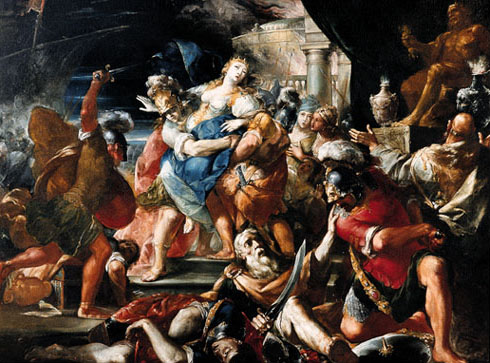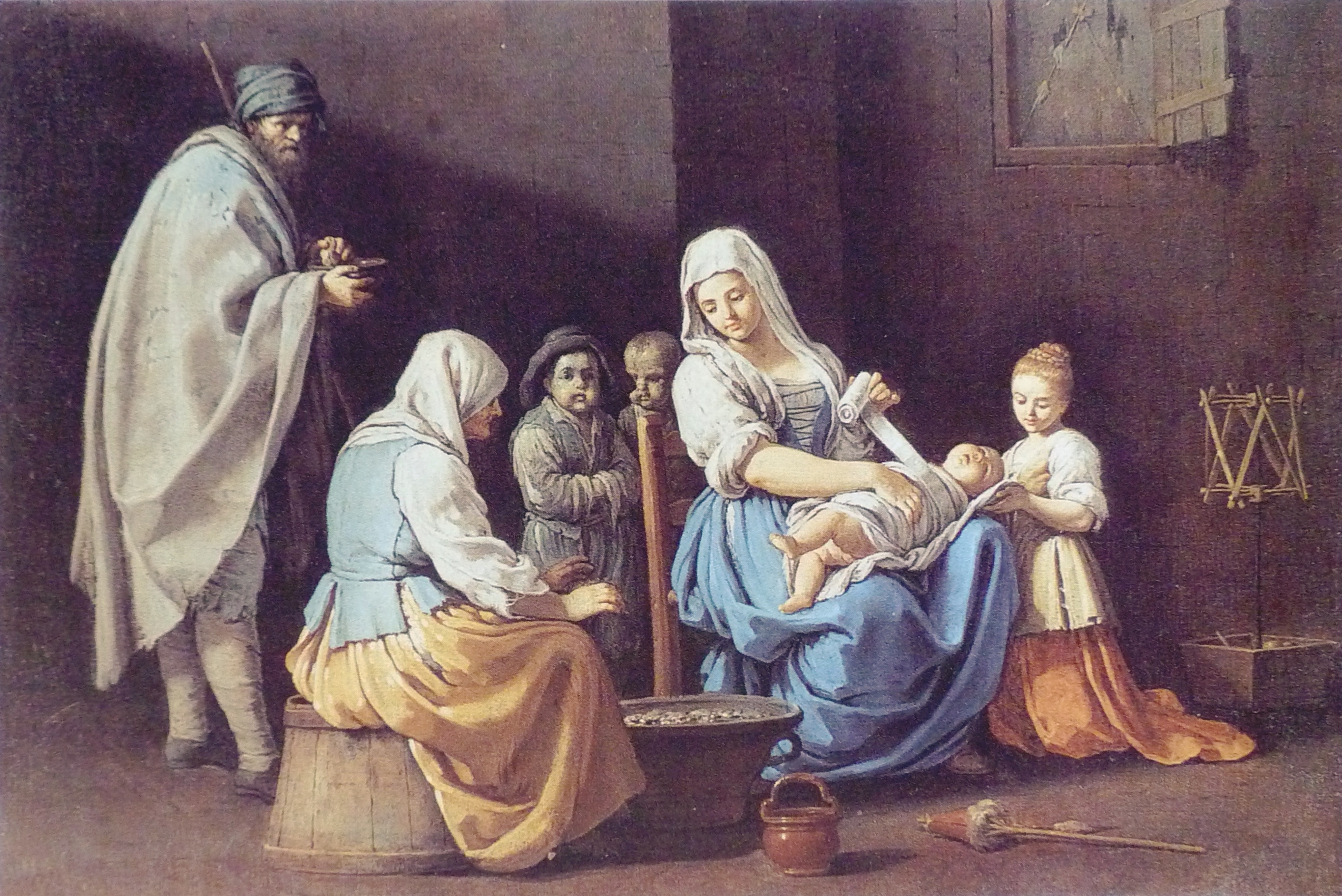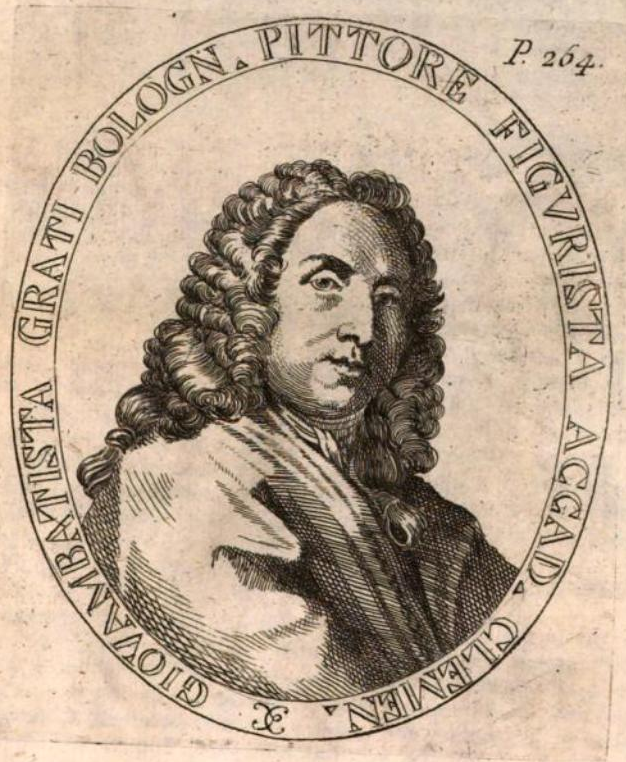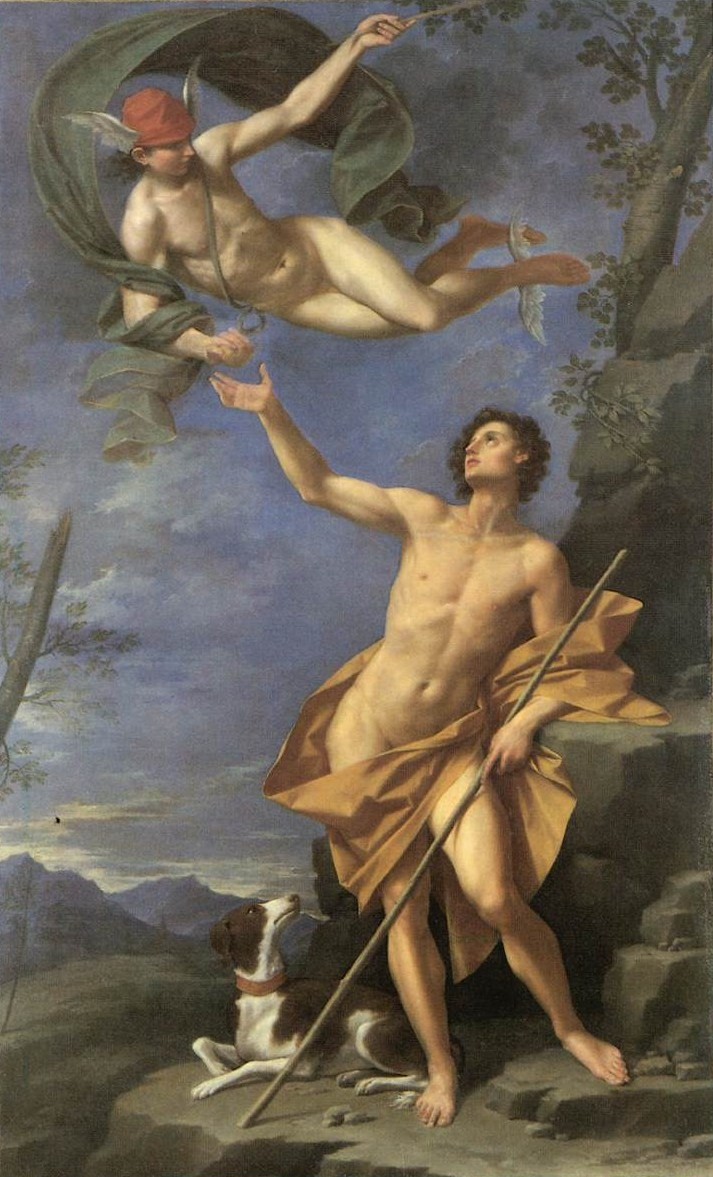|
Giovanni Giuseppe Dal Sole
Giovanni Gioseffo dal Sole (10 December 1654 – 22 July 1719) was an Italian painter and engraver from Bologna, active in the late-Baroque period. Upon the death of Carlo Cignani, Gioseffo dal Sole became among the most prominent painters in Bologna, described as the ''Guido Moderno''. Biography His father, Giovanni Antonio Maria, also called ''Mochino de` Paesi'' due to his ambidextrous dexterity, was a landscape painter who trained with Francesco Albani. Giovanni Gioseffo first apprenticed with Domenico Maria Canuti, and then in 1672; he entered the Roman studio of Lorenzo Pasinelli. He painted frescoes in the cupola of ''Santa Maria dei Poveri'' in Bologna, and an altarpiece of the ''Trinity'' (1700) for the ''Chiesa del Suffragio'' in Imola. He is said to have collaborated with Giuseppe Maria Crespi. He was one of the painters who contributed a canvas depicting the mythologic scene of ''Andromache weeping before Aeneas'' for the renowned ''Aenid Gallery'' of the Palazzo Bu ... [...More Info...] [...Related Items...] OR: [Wikipedia] [Google] [Baidu] |
Italy
Italy ( it, Italia ), officially the Italian Republic, ) or the Republic of Italy, is a country in Southern Europe. It is located in the middle of the Mediterranean Sea, and its territory largely coincides with the homonymous geographical region. Italy is also considered part of Western Europe, and shares land borders with France, Switzerland, Austria, Slovenia and the enclaved microstates of Vatican City and San Marino. It has a territorial exclave in Switzerland, Campione. Italy covers an area of , with a population of over 60 million. It is the third-most populous member state of the European Union, the sixth-most populous country in Europe, and the tenth-largest country in the continent by land area. Italy's capital and largest city is Rome. Italy was the native place of many civilizations such as the Italic peoples and the Etruscans, while due to its central geographic location in Southern Europe and the Mediterranean, the country has also historically been home ... [...More Info...] [...Related Items...] OR: [Wikipedia] [Google] [Baidu] |
Giuseppe Gambarini
Giuseppe Gambarini (1680 – 11 September 1725) was an Italian painter of the late-Baroque period, active mainly in Bologna. He was a pupil of the painters Lorenzo Pasinelli and Cesare Gennari. He also painted frescoes in the Palazzo Buonaccorsi in Macerata Macerata () is a city and ''comune'' in central Italy, the county seat of the province of Macerata in the Marche region. It has a population of about 41,564. History The historical city centre is on a hill between the Chienti and Potenza ri .... He is also called ''Gioseffo Gambarini''. One of his pupils was Stefano Gherardini A 20th-century landscape artist has the same name. References * External links 1680 births 1725 deaths 17th-century Italian painters Italian male painters 18th-century Italian painters Painters from Bologna Italian Baroque painters 18th-century Italian male artists {{Italy-painter-17thC-stub ... [...More Info...] [...Related Items...] OR: [Wikipedia] [Google] [Baidu] |
Giovanni Battista Grati
Giovanni Battista Grati (8 August 1681 – 1758) was an Italian painter from Bologna, active in the late-Baroque period. Biography Grati apprenticed with Giovanni Gioseffo Dal Sole. After traveling to various cities, including Bolzano and Cortona, he returned to Bologna in 1719, and was named Prince of the Accademia Clementina. His election followed the death of the first Prince of this Academy, the by-then elderly Carlo Cignani. The young Grati nominated Marcantonio Franceschini as vice-prince, and had a board of directors consisting of Antonio Burrini, Felice Torelli, Donato Creti Donato Creti (24 February 1671 – 31 January 1749) was an Italian painter of the Rococo period, active mostly in Bologna. Born in Cremona, he moved to Bologna, where he was a pupil of Lorenzo Pasinelli. He is described by Wittkower as the "Bol ..., Angelo Michele Cavazzoni, Andrea Ferreri, Giuseppe Carpi, Ferdinando Bibiena, and Luca Bistega. He taught figure painting for many years. [...More Info...] [...Related Items...] OR: [Wikipedia] [Google] [Baidu] |
Donato Creti
Donato Creti (24 February 1671 – 31 January 1749) was an Italian painter of the Rococo period, active mostly in Bologna. Born in Cremona, he moved to Bologna, where he was a pupil of Lorenzo Pasinelli. He is described by Wittkower as the "Bolognese Marco Benefial", in that his style was less decorative and edged into a more formal neoclassical style. It is an academicized grand style, that crystallizes into a manneristic neoclassicism, with crisp and frigid modeling of the figures. Among his followers were Aureliano Milani, Francesco Monti, and Ercole Graziani the Younger. Two other pupils were Domenico Maria Fratta and Giuseppe Peroni. Astronomical canvases One memorable conceit in Creti's output is a series of small canvases depicting celestial bodies, disproportionately sized and illuminated, above nocturnal landscapes. The paintings, commissioned in 1711 by the Bolognese count Luigi Marsili and intended as a gift to Pope Clement XI, were meant to accentuate the need fo ... [...More Info...] [...Related Items...] OR: [Wikipedia] [Google] [Baidu] |
Gioseffo Vitali
Gioseffo Vitali (active 1700) was an Italian painter of the late-Baroque period. He was born in Bologna. He trained under Giovanni Gioseffo dal Sole Giovanni Gioseffo dal Sole (10 December 1654 – 22 July 1719) was an Italian painter and engraver from Bologna, active in the late-Baroque period. Upon the death of Carlo Cignani, Gioseffo dal Sole became among the most prominent painters in Bolo .... In Bologna, he painted an ''Annunciation'' for the church of Sant' Antonio; a ''S. Petronio'' for SS. Sebastiano e Rocco; and a ''Martyrdom of St. Cecilia'' in the church of that saint. References * 17th-century Italian painters Italian male painters Painters from Bologna Italian Baroque painters Year of death unknown Year of birth unknown {{Italy-painter-17thC-stub ... [...More Info...] [...Related Items...] OR: [Wikipedia] [Google] [Baidu] |
Bastiano Galleoti
Sebastiano Galeotti (1656–1746) was a peripatetic Italian painter of the late-Baroque period, active in Florence, Genoa, Parma, Piacenza, Codogno, Lodi, Cremona, Milan, Vicenza, Bergamo, and Turin. Born in Florence, he was a pupil of the painter Alessandro Gherardini, Felice Torelli, and Giovanni Gioseffo dal Sole. He collaborated with Giovanni Domenico Ferretti or Francesco Natali of Cremona in some projects, and among his pupils were Vincenzo Meucci. He painted with Natali in the Oratory of Santa Maria delle Grazie, Parma. He helped decorate with frescoes the rooms of the Farnese Rocca in Sala Baganza. Died in Mondovì working for the House of Savoy. He decorated the church of the Magdalen in Genoa. In Turin, he was appointed director of the Academy, the precursor of the Accademia Albertina. His son Giuseppe Giuseppe is the Italian form of the given name Joseph, from Latin Iōsēphus from Ancient Greek Ἰωσήφ (Iōsḗph), from Hebrew יוסף. It is the most com ... [...More Info...] [...Related Items...] OR: [Wikipedia] [Google] [Baidu] |
Francesco Monti (Bologna)
Francesco Monti (1685 – 14 April 1768) was an Italian painter of the late Baroque. ''Death of St Anne'', originally in church of San Zeno al Foro, Brescia. Biography Born in Bologna, he studied art for three years with Sigismondo Caula in Modena, and then starting in 1701 with Giovanni Gioseffo dal Sole in Bologna. His neo-Mannerist style was influenced by Donato Creti, Giuseppe Maria Crespi, and Parmigianino. A prolific painter, he worked in oil and in fresco. His first known work, dating from 1713, is a ''Pentecost'' for the Basilica of San Prospero in Reggio Emilia. Other early works include a ''Rape of the Sabines'' for Count Ranuzzi and a ''Triumph of Mordecai'' for the court at Turin. Around this time, he was commissioned, along with other painters, to provide decorations for the Duke of Richmond's Goodwood Palace. He also executed commissions for a number of churches in Bolognia. Within a few years, he was admitted to the prestigious Accademia Clementina. In ... [...More Info...] [...Related Items...] OR: [Wikipedia] [Google] [Baidu] |
Antonio Beduzzi
Antonio Maria Nicolao Beduzzi (1675–1735) was an Austrian-Italian theater engineer, painter, and architect who flourished in Vienna at the turn of the 17th century. He was born in Bologna in 1675. He succeeded Burnacini as the theatre architect at the Court in Vienna in 1708. Among his better known designs are: * The interior of Melk Abbey for Jakob Prandtauer's baroque reconstruction * Leopoldsberg church on Leopoldsberg above Klosterneuburg, near Vienna * The cathedral museum of Passau * Vienna's ''Theater am Kärntnertor'' (the site now occupied by Hotel Sacher) * The frescos of the ''Landhaussaal'' in the Viennese Palais Niederösterreich Beduzzi died in Vienna in 1735. Gallery File:Maria Taferl Basilika Langhausfresko 01.JPG, ''Glorification of Saint Joseph Joseph (; el, Ἰωσήφ, translit=Ioséph) was a 1st-century Jewish man of Nazareth who, according to the canonical Gospels, was married to Mary, the mother of Jesus, and was the legal father of Jesus. Th ... [...More Info...] [...Related Items...] OR: [Wikipedia] [Google] [Baidu] |
Lucia Casalini
Lucia Casalini Torelli (1677–1762) was an Italian painter, active in Bologna. The wife of painter Felice Torelli (and, through him, sister-in-law of violinist and composer Giuseppe Torelli), she was the mother of painter Stefano Torelli. She was born in Bologna, where she trained under Giovanni Gioseffo dal Sole. Life and works Daughter of Antonio Casalini and Antonia Bandiera, she began studying painting with her cousin, Carlo Casalini. However at the age of thirteen she entered the atelier of the prominent Bolognese painter, Giovanni Gioseffo dal Sole, Giovanni Gioseffo Dal Sole. Here she met her future husband, also a successful painter Felice Torelli, who was regularly sent by the master to the young girl's home to bring her drawings to copy. The two married in 1701, and soon opened their own studio with students. They had seven children, two of whom, Anna and Stefano, became artists. In 1706, Felice Torelli was one of the founders of the Accademia Clementina; Lucia was ... [...More Info...] [...Related Items...] OR: [Wikipedia] [Google] [Baidu] |
Felice Torelli
Felice Torelli (9 September 1667 – 11 June 1748) was an Italian painter of the Baroque style, active mainly in Bologna. Biography He was born to a family of artists in Verona, including his brother, Giuseppe Torelli, a noted violinist and composer of concerti. Both his son, Stefano Torelli, and his wife, Lucia Casalini (1677–1762), were painters. His wife mainly painted portraits. Felice was initially apprenticed to Santi Prunati in Verona, then to Giovanni Gioseffo dal Sole in Bologna. In 1710, Torelli was one of the founders of the ''Accademia Clementina'' in Bologna, and during his time there, Giuseppe Maria Crespi was a member. Torelli's pupils at the academy included the two brothers Ubaldo Gandolfi and Gaetano Gandolfi; his nephew, Giovanni Giorgi; Mariano Collina (died 1780); and Antonio Magnoni [...More Info...] [...Related Items...] OR: [Wikipedia] [Google] [Baidu] |
Lucca
Lucca ( , ) is a city and ''comune'' in Tuscany, Central Italy, on the Serchio River, in a fertile plain near the Ligurian Sea. The city has a population of about 89,000, while its province has a population of 383,957. Lucca is known as one of the Italian's "Città d'arte" (Arts town), thanks to its intact Renaissance-era city walls and its very well preserved historic center, where, among other buildings and monuments, are located the Piazza dell'Anfiteatro, which has its origins in the second half of the 1st century A.D. and the Guinigi Tower, a tower that dates from the 1300s. The city is also the birthplace of numerous world-class composers, including Giacomo Puccini, Alfredo Catalani, and Luigi Boccherini. Toponymy By the Romans, Lucca was known as ''Luca''. From more recent and concrete toponymic studies, the name Lucca has references that lead to "sacred wood" (Latin: ''lucus''), "to cut" (Latin: ''lucare'') and "luminous space" (''leuk'', a term used by the firs ... [...More Info...] [...Related Items...] OR: [Wikipedia] [Google] [Baidu] |
Palazzo Spalletti-Trivelli
Palazzo Spalletti-Trivelli (formerly Guicciardi) is a palace located at Via Emilia A San Pietro #2, corner with Via San Nicolò, in the center of the city of Reggio Emilia, region of Emilia Romagna, Italy. The building now belongs to the Credito Emiliano (Credem) bank, and owns the art collection now in the palace. History The building was erected atop ancient Roman ruins, still visible in the basement. A large house or palace was owned by the Bosi Family until 1685. It was rebuilt in the 1700s under the patronage of the new owner Count Guicciardi using designs by the architect Giovanni Maria Ferraroni, and refurbished in the early 1800s in a Neoclassical style by Pietro Marchelli, when the palace was acquired by the Spalletti-Trivelli family, who also owned the adjacent building. A salon of the piano nobile has a ceiling painting depicting ''Apollo with the Court of the Hours'' by Prospero Minghetti, and a ball room with ''trompe-l'œil'' colonnades and curtains painted by Vin ... [...More Info...] [...Related Items...] OR: [Wikipedia] [Google] [Baidu] |






